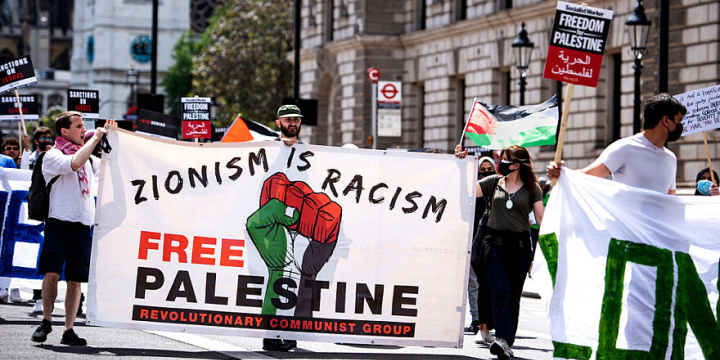Incidents of online antisemitism dropped nine percent, going from 1,360 in 2023 to 1,240 in 2024 and amounting to 35 percent of total incidents.
By David Swindle, The Algemeiner
The United Kingdom experienced its second worst year for antisemitism in 2024, despite recording an 18 percent drop in antisemitic incidents from the previous year’s all-time high, according to a report published last week.
The Community Security Trust (CST), a nonprofit charity that advises Britain’s Jewish community on security matters, released data showing it recorded 3,528 antisemitic incidents for 2024, a drop of 18 percent from the 4,296 in 2023. These numbers compare to 1,662 antisemitic incidents in 2022, 2,261 in 2021, and 1,684 in 2020.
Last year’s total “is a reflection of the sustained levels of antisemitism that have been recorded across the UK since the Hamas terror attack in Israel on Oct. 7, 2023,” CST said of its findings.
“CST’s Antisemitic Incidents Report 2023 charted the immediacy and scope of the rise in anti-Jewish hate following that attack, before Israel had set in motion any extensive military response in Gaza.”
Each month in 2024, with the exception of December, saw more than 200 incidents of antisemitism.
Before 2023, CST had only recorded that many in five months, also during periods inflamed by conflicts in the Middle East.
The heaviest months last year were February (446), January (392), and March (321).
Having reviewed such data for years, CST saw a recurring pattern that “when a trigger event such as the Oct. 7 attack occurs, antisemitic incidents initially spike to a record peak; then gradually recede until they plateau at a higher level than before the original trigger event occurred.”
CST noted that anti-Israel protests had continued in the UK but decreased in quantity and in the numbers of participants compared to 2023. The report found that anti-Israel statements featured in 52 percent of incidents, an increase from 2023’s 43 percent.
CST also found that for 73 percent of incidents, the perpetrator invoked “one or more political or ideological discourses, motivations, tropes or conspiracy theories.”
This is an increase from 64 percent in 2023 and 50 percent in 2022. Incidents featuring two or more of these themes fueled 10 percent, a rise from 2023’s six percent.
The group said that the “coexistence of multiple rhetoric strands within the same incident reflects the complexity of contemporary antisemitism.
Numerous stereotypes and myths about Jewish people are deeply embedded in collective and individual consciousness and shared by different extremist ideologies and movements, forming a library of reference points from which antisemites from distinct value systems can draw.”
The report broke down the types of incidents, identifying 201 assaults, including one so severe that the CST identified it as “extreme violence (meaning it involved grievous bodily harm or a threat to life) whereas none did the previous year.”
These comprised 6 percent of total incidents. Property damage and desecration hate crimes dropped 19 percent from 2023, going from 195 to 157.
These included 40 at homes or vehicles of Jews, 37 vandalizing posters or memorials to Hamas’s victims, 19 targeting Jewish businesses or organizations, 19 against synagogues, and eight at Jewish schools.
The number of threats also fell in 2024, going down 20 percent to 314 incidents, the second highest year recorded. Other specific categories of hate included abusive behavior (2,892 reports) and mass-produced antisemitic literature (27 reports).
CST emphasized that “a high volume of anti-Jewish hate was reported in the school sector.”
The group identified 63 antisemitic incidents recorded at Jewish schools, 88 incidents involved Jewish schoolchildren away from school (particularly during morning commutes), and 109 incidents targeted Jewish schoolchildren or staff at secular schools.
The total of school-based incidents also dropped from 2023, going from 355 to 260.
The report identified the manifestations of antisemitism at the college level, finding 145 incidents which involved students, academics, student unions, or other campus groups.
Antisemites targeted synagogues in 164 incidents and in 59 targeted Jews walking to religious services. More than a third of incidents aimed at synagogues included hateful or threatening messages by phone or email.
Incidents of online antisemitism dropped nine percent, going from 1,360 in 2023 to 1,240 in 2024 and amounting to 35 percent of total incidents. Seventy-one percent of these incidents involved Israel.
CST cautioned that “this total for online incidents is only indicative, as the actual amount of antisemitic content that is generated and disseminated through online platforms is much larger. In some cases, social media has been used as a tool for coordinated campaigns of antisemitic harassment, threats and abuse directed at Jewish public figures and other individuals.”
Regarding antisemitic themes in incidents, Holocaust or Nazi-era rhetoric featured in 909 reports, for 26 percent of the total. Some incidents featured Holocaust denial (61) while others chose Holocaust celebration (138).
CST also highlighted that “on eight occasions, perpetrators simultaneously denied and glorified the Holocaust, showcasing the twisted logic and cognitive dissonance that can exist in the minds of those who hate Jews.”


